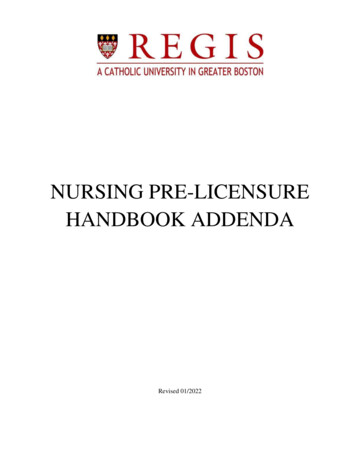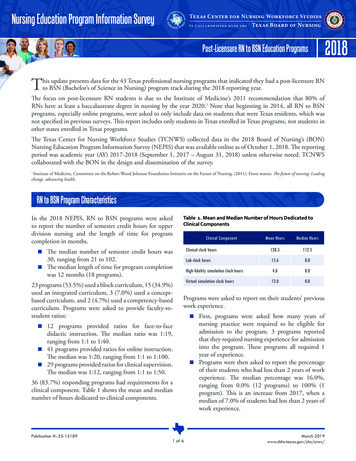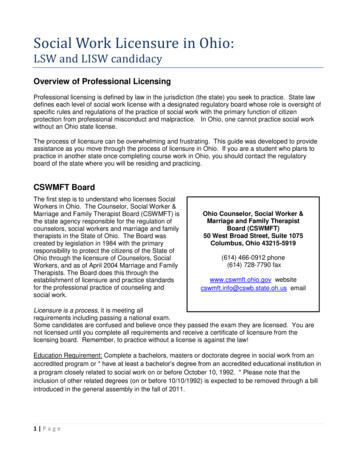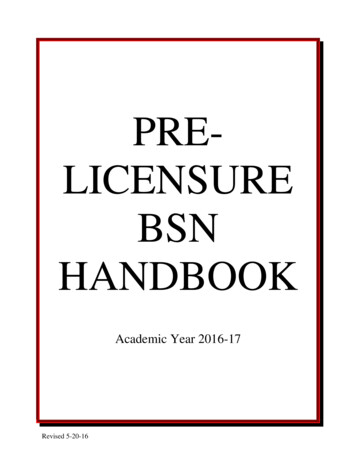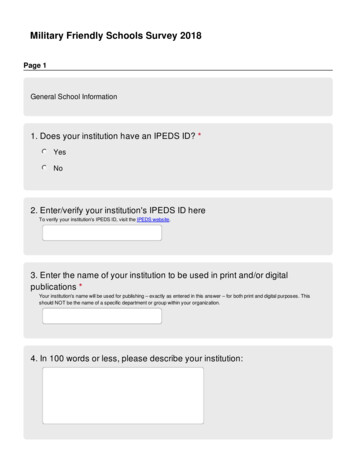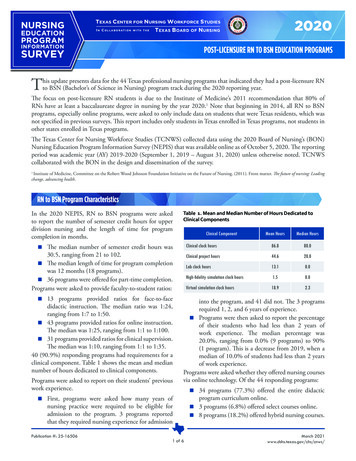
Transcription
NURSINGEDUCATION2020TEXAS CENTER FOR NURSING WORKFORCE STUDIESI N C O L L A B O R AT I O NWITH THET EXAS B OARD OF N URSINGPROGRAMINFORMATIONPOST-LICENSURE RN TO BSN EDUCATION PROGRAMSSURVEYThis update presents data for the 44 Texas professional nursing programs that indicated they had a post-licensure RNto BSN (Bachelor’s of Science in Nursing) program track during the 2020 reporting year.The focus on post-licensure RN students is due to the Institute of Medicine’s 2011 recommendation that 80% ofRNs have at least a baccalaureate degree in nursing by the year 2020.1 Note that beginning in 2014, all RN to BSNprograms, especially online programs, were asked to only include data on students that were Texas residents, which wasnot specified in previous surveys. This report includes only students in Texas enrolled in Texas programs, not students inother states enrolled in Texas programs.The Texas Center for Nursing Workforce Studies (TCNWS) collected data using the 2020 Board of Nursing’s (BON)Nursing Education Program Information Survey (NEPIS) that was available online as of October 5, 2020. The reportingperiod was academic year (AY) 2019-2020 (September 1, 2019 – August 31, 2020) unless otherwise noted. TCNWScollaborated with the BON in the design and dissemination of the survey.Institute of Medicine, Committee on the Robert Wood Johnson Foundation Initiative on the Future of Nursing. (2011). Front matter. The future of nursing: Leadingchange, advancing health.1RN to BSN Program CharacteristicsIn the 2020 NEPIS, RN to BSN programs were askedto report the number of semester credit hours for upperdivision nursing and the length of time for programcompletion in months.Table 1. Mean and Median Number of Hours Dedicated toClinical ComponentsClinical ComponentThe median number of semester credit hours was30.5, ranging from 21 to 102.The median length of time for program completionwas 12 months (18 programs).36 programs were offered for part-time completion.Programs were asked to provide faculty-to-student ratios:13 programs provided ratios for face-to-facedidactic instruction. The median ratio was 1:24,ranging from 1:7 to 1:50.43 programs provided ratios for online instruction.The median was 1:25, ranging from 1:1 to 1:100.31 programs provided ratios for clinical supervision.The median was 1:10, ranging from 1:1 to 1:35.40 (90.9%) responding programs had requirements for aclinical component. Table 1 shows the mean and mediannumber of hours dedicated to clinical components.Programs were asked to report on their students’ previouswork experience.Median HoursClinical clock hours86.880.0Clinical project hours44.620.0Lab clock hours13.10.0High-fidelity simulation clock hours1.50.0Virtual simulation clock hours18.92.3into the program, and 41 did not. The 3 programsrequired 1, 2, and 6 years of experience.Programs were then asked to report the percentageof their students who had less than 2 years ofwork experience. The median percentage was20.0%, ranging from 0.0% (9 programs) to 90%(1 program). This is a decrease from 2019, when amedian of 10.0% of students had less than 2 yearsof work experience.Programs were asked whether they offered nursing coursesvia online technology. Of the 44 responding programs:First, programs were asked how many years ofnursing practice were required to be eligible foradmission to the program. 3 programs reportedthat they required nursing experience for admissionPublication #: 25-16506Mean Hours1 of 634 programs (77.3%) offered the entire didacticprogram curriculum online.3 programs (6.8%) offered select courses online.8 programs (18.2%) offered hybrid nursing courses.March 2021www.dshs.texas.gov/chs/cnws/
Qualified Applications to Post-Licensure RN to BSN ProgramsTable 2 presents data on qualified applications andadmissions to post-licensure RN to BSN programs in AY2019-2020. Qualified applications were those that metall criteria for admission.2173 qualified applications were not admitted in2019, up from 116 qualified applications in 2019.Table 2. Qualified Applications, Admissions, and QualifiedApplications Not Offered Admission, 2014-202040 of 44 programs (90.9%) offered admission to allstudents with qualified applications in 2020.QualifiedOffered ApplicationsAdmission Not OfferedAdmissionapplications offered admission, and newly enrolledstudents only include Texas or 4,85876 (1.5%)4,021201512,2475,1984,752446 (8.6%)4,135201612,9005,2045,12282 (1.6%)4,573201714,5477,0046,93272 (1.0%)6,039201814,4847,4267,287138 (1.9%)4,768201918,6428,6288,512116 (1.3%)5,514202017,0858,5308,357173 (2.0%)5,873Of the 8,357 applications offered admission, 5,873(70.3%) registered and enrolled in a post-licensureRN to BSN program for AY 2019-2020, an increasefrom the previous year (64.8%).The 2 programs that did not accept all qualifiedapplications ranked the importance of reasons whyqualified applications were not accepted.One reported that lack of budgeted facultypositions was the most important reason whyqualified applications were not accepted, and onereported that lack of clinical space was the mostimportant reason why qualified applications werenot accepted.5 programs did not admit new RN to BSNapplicants in AY 2019-2020.Seats for new students decreased by 8.4% in 2020,while the number of responding programs increasedby 3.Seats for new students may include seats for outof-state students, but qualified applications,Qualified applications refers to applications submitted, not individualapplicants, since candidates for admission may apply to more than one nursingprogram.2Seats for new students does not distinguish between non-Texas and Texasresidents.3Per the survey operational definition, seats for new students refers to themaximum number of seats for new students that a program can enroll in anygiven admission period. Seats for new students may be limited by Board ofNursing rules or logistical concerns (faculty size, classroom space, etc.).4Newly Enrolled Students in Post-Licensure RN to BSN ProgramsTable 3 shows the yearly change in newly enrolled, first yearstudents from 2014 to 2020. Newly enrolled students arethose who were offered admission and decided to registerand enroll in the program.Table 3. Change in Newly Enrolled Students, 2014-2020Number ofRespondingProgramsNewly Enrolled PostLicensure Students% AnnualChangeThere were a total of 5,873 newly enrolled postlicensure students in AY 2019-2020.2014284,021-2015404,1352.8%From AY 2018-2019 to AY 2019-2020, the numberof newly enrolled students increased by 1.0%2019415,51415.6%2020445,8736.5%Publication #: 25-165062 of 6March 2021www.dshs.texas.gov/chs/cnws/
Total Enrollment in Post-Licensure RN to BSN ProgramsOn September 30, 2020, as shown in Figure 1, there were7,875 students enrolled in post-licensure RN to BSNprograms.Figure 1. Total Enrollment in Post-Licensure RN to BSNPrograms, 2014-202012,000From 2019 to 2020, enrollment increased by 1,223students (18.4% increase) while the number ofresponding RN to BSN programs increased by 3.10,95710,00038 programs responded to the NEPIS in bothAY 2018-2019 and AY 2019-2020. 14 of theseprograms had a decrease in total enrollment, 18reported increased total enrollment, and 6 did nothave a change in enrollment.6,7706,0004,000Between 2019 and 2020, 2 programs closed, 5opened, and 1 did not respond to the survey. 3programs reported enrollees for the first time in2017, which could explain the large increase 01520162017201820192020Graduates from Post-Licensure RN to BSN ProgramsAs shown in Figure 2, there were 4,358 post-licensure RNto BSN graduates during AY 2019-2020.38 programs responded to the NEPIS in bothAY 2018-2019 and AY 2019-2020. 16 of theseprograms reported a decrease in the number of postlicensure RN to BSN graduates during AY 20192020 while 18 were able to increase the number ofgraduates. 4 programs reported the same number ofgraduates as AY 2018-2019.This represented a 6.1% increase from AY 20182019 (252 more graduates).Figure 2. Graduates from Post-Licensure RN to BSN 9024,106The 44 post-licensure RN to BSN programs were askedto describe any barriers they faced in increasing postlicensure RN to BSN graduates.A variety of barriers were cited including lack ofclinical space/competition with other programs (8programs or 18.2%), cost of program or studentfinancial difficulties (4 programs or 9.1%), and adecrease in applications (3 programs or 92020Publication #: 25-165063 of 6March 2021www.dshs.texas.gov/chs/cnws/
Demographics of Newly Enrolled Post-Licensure RN to BSN StudentsSexFemales made up 85.8% of the 2020 newly enrolledpost-licensure RN to BSN student population, almostunchanged from the proportion who were female in 2019(85.5%). Gender data were missing for 0.3% of newlyenrolled RN to BSN students.Figure 4.Race/Ethnicity of Newly Enrolled RN to BSNStudents, Pre-Licensure RN Students,6 and Texas Population,7202060%50% 47.3%41.2%40.9%40%Age30%Figure 3 displays the breakdown of age among newlyenrolled post-licensure RN to BSN students in 2020. Agedata were missing for 1.7% of newly enrolled RN to BSNstudents.20%10%41-50 years21.3%%21-25 ian Black/African Hispanic/LatinoAmericanOtherHispanics/Latinos continued to be underrepresentedamong post-licensure RN to BSN students. Whilethe proportion of Hispanics/Latinos was 39.8% inTexas, Hispanics/Latinos made up only 26.7% ofthe post-licensure RN to BSN student population,compared to 29.6% of the pre-licensure RN studentpopulation.26-30 years21.4%31-40 years36.6%There were more Black/African American RN toBSN students (17.1%) compared to pre-licensureRN students (15.7%) and the Texas population(12.0%).Newly enrolled RN to BSN students remainedfairly evenly distributed among age groups 21-30,31-40, and 41 or more years.There were considerably more post-licensure RN toBSN students aged 51 and older (7.3%) comparedto pre-licensure RN students (1.4%).6Other students, which include Asian, NativeHawaiian, Alaskan, and other races/ethnicities, alsorepresented a greater proportion of the post- andpre-licensure student population than the Texaspopulation.Race/EthnicityFigure 4 displays the race/ethnicity distribution of postlicensure RN to BSN students in comparison to the race/ethnicity distribution of pre-licensure RN students andthe projected Texas population. Race/ethnicity data weremissing for 4.5% of newly enrolled RN to BSN students.White/Caucasian students made up a greaterproportion of post-licensure RN to BSN newlyenrolled students (47.3%) compared to prelicensure RN students (41.2%) and compared tothe Texas population (40.9%). The post-licensureRN to BSN White/Caucasian student proportionwas lower than in 2019 (51.8%).Publication #: 25-1650629.6%26.7%0Figure 3. Age of Newly Enrolled Students51 years7.3%Newly Enrolled RN to BSN StudentsNewly Enrolled Pre-Licensure RN StudentsProjected Texas Population39.8%Since 2014 the race/ethnicity distribution of newlyenrolled RN to BSN students has fluctuated butremained mostly unchanged (Figure 5, page 5).International StudentsPrograms reported a total of 57 newly enrolled studentswho were international (1.0% of all RN to BSN newlyenrolled students).84 of 6March 2021www.dshs.texas.gov/chs/cnws/
Figure 5. Race/Ethnicity of Newly Enrolled RN to BSNStudents, 2014-2020Pre-licensure RN data come from the 2020 RN NEPIS fact sheets located shtm#Professional.660%Texas population data come from the 2020 Texas Demographic al was defined as a person who is not a citizen or permanentresident of the United States and who is in this country on a temporary basisand does not have the right to remain 201620172018Black/African American20192020Hispanic/LatinoOtherDemographics of Post-Licensure RN to BSN GraduatesSexRace/EthnicityFemales made up 86.8% of the 2020 post-licensure RNto BSN graduate population, almost unchanged from theproportion who were female in 2019 (87.6%). Genderdata were available for all graduates.Figure 7 displays the race/ethnicity distribution of postlicensure RN to BSN graduates in comparison to the race/ethnicity distribution of pre-licensure RN graduates andthe Texas population. Race/ethnicity data were missingfor 4.0% of RN to BSN graduates.AgeFigure 6 displays the breakdown of age among postlicensure RN to BSN graduates in 2020. Age data weremissing for 1.3% of RN to BSN graduates.Figure 7.Race/Ethnicity of RN to BSN Graduates, Pre-LicensureRN Graduates,6 and Texas Population,7 202060%Figure 6. Age of Graduates50%51 years 21-25 years9.2%8.6%40%20%10%0%31-40 years37.2%RN to BSN graduates were fairly evenly distributedamong age groups 21-30, 31-40, and 41 or moreyears.There were considerably more post-licensure RN toBSN graduates aged 51 and older (9.2%) comparedto pre-licensure RN graduates (2.0%).6Publication #: 25-1650646.1%40.9%RN to BSN GraduatesPre-Licensure RN GraduatesProjected Texas Population39.8%29.0%30%26-30 years21.5%41-50 years23.6%55.0%5 of 621.3%15.0%12.3%12.0%12.6%8.7%7.3%White/Caucasian Black/African Hispanic/LatinoAmericanOtherWhite/Caucasian graduates made up a higherproportion of post-licensure RN to BSN graduates(55.0%) than pre-licensure RN graduates (46.1%),and the Texas population (40.9%). The postlicensure RN to BSN White/Caucasian graduateproportion decreased from 2019 (56.2%).March 2021www.dshs.texas.gov/chs/cnws/
While the proportion of Hispanics/Latinos was39.8% in Texas, Hispanics/Latinos made up only21.3% of post-licensure RN to BSN graduates,compared with 29.0% of pre-licensure RN graduates.Figure 8. Race/Ethnicity of RN to BSN Graduates, 2014-2020There were more Black/African American postlicensure RN to BSN graduates (15.0%) comparedto pre-licensure RN graduates (12.3%) and theTexas population (12.0%).60%50%40%30%Other races/ethnicities also represented a greaterproportion of the post- and pre-licensure graduatepopulation than the Texas population.20%Since 2014 the proportion of RN to BSN graduateswho were other races/ethnicities has decreased by25.7% (Figure 8). The proportions of other raceshave fluctuated since 2014 but remained 172018Black/African American20192020Hispanic/LatinoOtherInternational StudentsPrograms reported a total of 37 graduates who wereinternational students (0.8% of all post-licensure RN toBSN graduates).8Pre-licensure RN data come from the 2020 RN NEPIS fact sheets located at: m#Professional.6Texas population data come from the 2020 Texas Demographic Center population projections ions/).7International was defined as a person who is not a citizen or permanent resident of the United States and who is in this country on a temporary basis and does nothave the right to remain indefinitely.8Publication #: 25-165066 of 6March 2021www.dshs.texas.gov/chs/cnws/
Figure 2. Graduates from Post-Licensure RN to BSN Programs, 2014-2020 Figure 1. Total Enrollment in Post-Licensure RN to BSN Programs, 2014-2020 On September 30, 2020, as shown in Figure 1, there were 7,875 students enrolled in post-licensure RN to BSN programs. From 2019 to 2020, enrollment increased by 1,223
